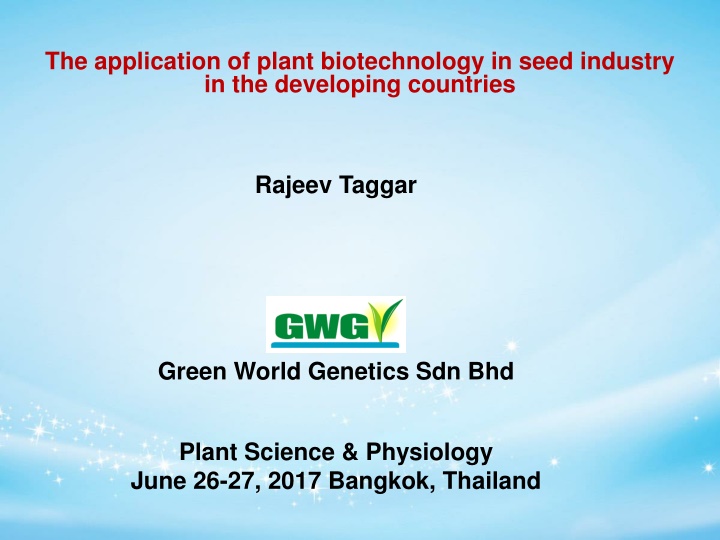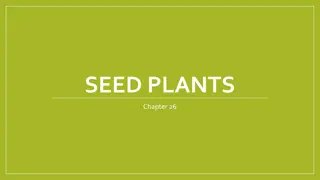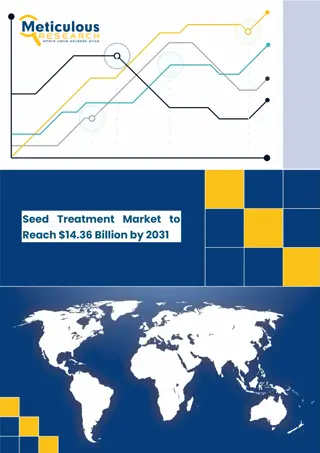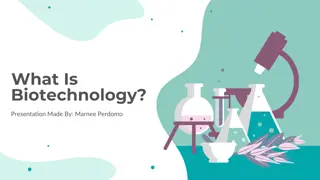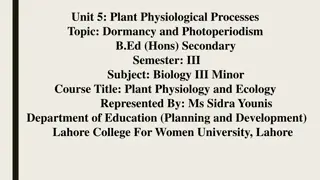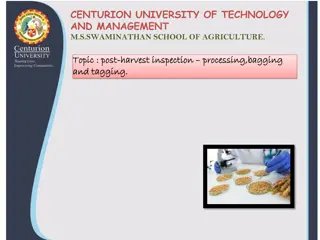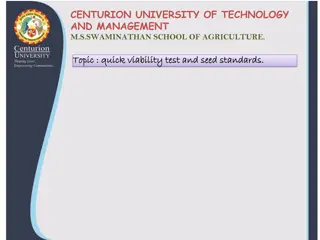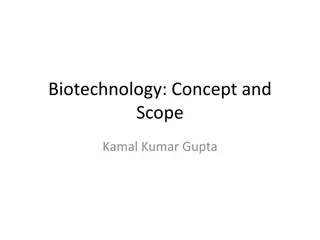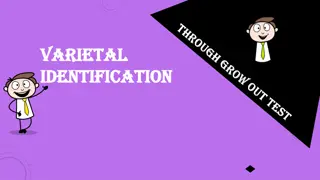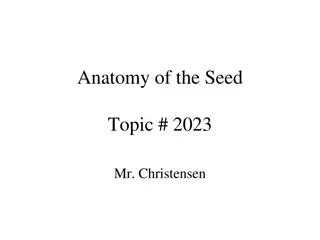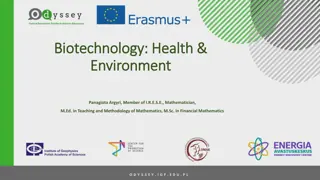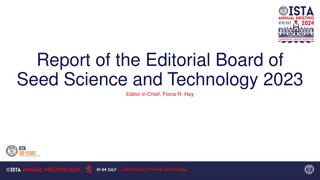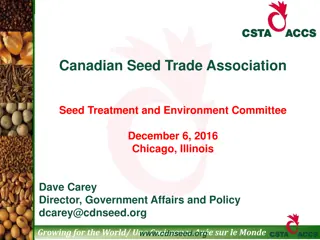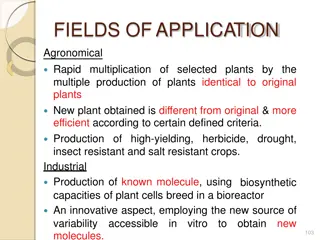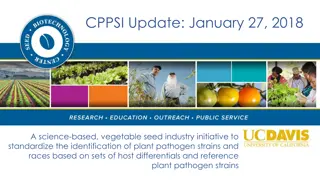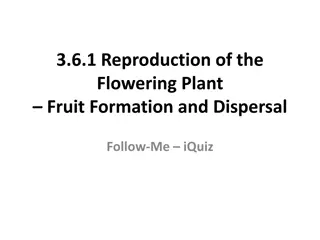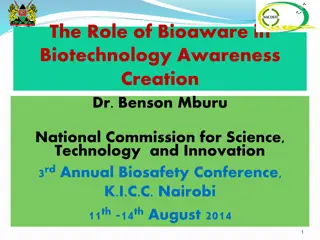The application of plant biotechnology in seed industry in the developing countries
In the developing countries, the utilization of plant biotechnology in the seed industry is imperative for growth, focusing on the importance of localized seed production, technology advancements, and addressing industry gaps to maximize gains and foster self-reliance. This presentation by Rajeev Taggar delves into the structure, challenges, and potential of the seed industry in the context of biotech applications.
Download Presentation

Please find below an Image/Link to download the presentation.
The content on the website is provided AS IS for your information and personal use only. It may not be sold, licensed, or shared on other websites without obtaining consent from the author.If you encounter any issues during the download, it is possible that the publisher has removed the file from their server.
You are allowed to download the files provided on this website for personal or commercial use, subject to the condition that they are used lawfully. All files are the property of their respective owners.
The content on the website is provided AS IS for your information and personal use only. It may not be sold, licensed, or shared on other websites without obtaining consent from the author.
E N D
Presentation Transcript
The application of plant biotechnology in seed industry in the developing countries Rajeev Taggar 2 Green World Genetics Sdn Bhd Plant Science & Physiology June 26-27, 2017 Bangkok, Thailand
The message Overview of plant biotechnology What the seed industry in developing countries actually needs The quick and easy way to make a difference: prioritization Gaps in the development of seed industry in developing countries How to address the gaps 26/6/2017 Rajeev Taggar 2
Contents - - Seed industry structure for biotech application Importance of localized small and medium scale seed industry in developing countries Plant biotech overview: Sections Technologies proven in seed industry Future biotech in seed industry Maximizing gains Conclusions References - - - - - - 26/6/2017 Rajeev Taggar 3
Seed industry structure & biotech The indigenous seed industry Small and medium scale seed industry Low-investment potential Low technological power Large trans-national seed companies Well established sales and marketing network Satellite biotech support laboratories High investment potential High technological power 26/6/2017 Rajeev Taggar 4
Importance of local seed industry Importance of local seed industry - Captures a consumer niche not addressed to by the large trans-national seed companies - Biodiversity conservation - Variety in food, better catering to local tastes and requirements - Self reliance, national economy - Check monopolization in seed industry 26/6/2017 Rajeev Taggar 5
Plant biotech overview: Sections Plant biotech overview: Sections Seed industry (Vegetable crops, Cereals, field crops, some fruit crops and ornamentals) Technologies: Molecular breeding, plant genetic transformation, molecular diagnostics, doubled haploids, embryo rescue Oil palm/Trees Technologies: Everything above, special focus micropropagation and somatic embryogenesis Floriculture Technologies: Special focus on Somatic embryogenesis, micropropagation, mutation breeding Public genebanks Technologies: Special focus on cryopreservation, tissue banking, artificial seeds Universities and public sector research institutes Technologies: All the above Pharmaceuticals Technologies: Molecular farming 26/6/2017 Rajeev Taggar 6
Biotechnology in seed industry Biotechnology in seed industry - - - - Molecular breeding Doubled Haploids Plant genetic transformation Molecular diagnostics 26/6/2017 Rajeev Taggar 7
Biotech seed industry: molecular breeding Biotech seed industry: molecular breeding Hybrid seed purity testing Hybrid seed purity testing DNA fingerprinting Marker-assisted-backcross Marker assisted selection Heterotic grouping Heterotic grouping 26/6/2017 Rajeev Taggar 8
Biotech in seed industry: DH Biotech in seed industry: DH Doubled Haploids - Uniformity 26/6/2017 Rajeev Taggar 9
Biotech in seed industry: Biotech in seed industry: transgenics transgenics Comparison of unsprayed Bt-cotton and non-Bt cotton 26/6/2017 Rajeev Taggar 10
Biotech in seed industry: molecular diagnostics Biotech in seed industry: molecular diagnostics Activities Hybrid seed purity testing Zygosity testing Pathogen detection Techniques PCR-ELISA Immuno assays / strip-tests FISH Microscopy Microbiological cultures DNA markers/probes DNA barcdoing 26/6/2017 Rajeev Taggar 11
NGS and Marker technologies NGS and Marker technologies - Sequencing/genotyping infrastructure not a constraint anymore Analytics the challenge now molecular breeding to information science Major marker technologies now: GBS, SNPs and SSRs - - 26/6/2017 Rajeev Taggar 12
Future trends Future trends - Big data handling information science molecular breeding - Cheap sequencers Oxford Nanopore, Illumina MiniSeq - Use of a wider germplasm base increased confidence in breaking harmful linkage drag using a dense molecular-markers coverage - Deciphering the molecular basis of heterosis over a hundred year old riddle clear role genetics and epigenetics tools developing once the mechanism discovered, dramatic improvement in hybrid crop varieties may be expected - Epigenetics increased application - how - Climate-change-ready crops - Genome editing - DH increased use inducer lines maize, rice 26/6/2017 Rajeev Taggar 13
Maximizing gains how? - - - - - Time-tested and proven technologies Quick delivery: short timelines Readily available technologies Minimal risk in investment: Minimal public and environmental concerns Minimal financial resources 26/6/2017 Rajeev Taggar 14
Maximizing gains low input industry Molecular breeding in small & medium seed industry Marker assisted selection/gene-stacking (MAS) Marker assisted backcross (MABC) Heterotic grouping DNA fingerprinting of inbred lines DNA fingerprinting of hybrids Germplasm management Germplasm characterization Diversity analysis Screening for biotic & abiotic stress resistances Removal of duplicates Purification of germplasm accessions Line stabilization Hybrid seed purity testing 26/6/2017 Rajeev Taggar 15
Maximizing gains high input industry Molecular breeding in large companies and academia Breeding by design (BBD) Genomics assisted breeding (GAB) Fine-level QTL mapping Association mapping Genome Wide Association Studies (GWAS) Nested association mapping (NAM) Multiparent Advanced Generation inter-Cross (MAGIC) Mutation breeding (TILLING/Eco-TILLING) Genomic selection Genome editing 26/6/2017 Rajeev Taggar 16
Maximizing gains: low input v/s high input Small & medium seed industry Focus: proven useful technology Academia & large seed industry Focus: Stay updated with technologies, market leader Marker assisted selection (MAS) Heterotic grouping DNA fingerprinting of inbred lines DNA fingerprinting of hybrids Germplasm management Germplasm characterization Diversity analysis Screening for biotic & abiotic stress resistances Removal of duplicates Purification of germplasm accessions Line stabilization Hybrid seed purity testing (GWAS) Nested association mapping (NAM) Multiparent Advanced Generation Inter-Cross (MAGIC) TILLING/Eco-TILLING Genomic selection (GS) Genome editing Breeding by design (BBD) Genomics assisted breeding (GAB) Fine-level QTL mapping Association mapping Genome Wide Association Studies 26/6/2017 Rajeev Taggar 17
Maximizing gains: low input v/s high input Comparison - Cheap infrastructure: MiniSeq $49,500, Oxford Nanopore MinIon $1,000 base unit Less number of markers ~300 v/s ~10,000 markers Analytical demands relatively low Returns on investment more assured - - - 26/6/2017 Rajeev Taggar 18
Maximizing gains Maximizing gains case of transgenic crops case of transgenic crops Transgenic technology (e.g. Bt genes) copy number analysis, insert size & sequence, elite event selection etc.: Extensive environmental and biosafety testing Field testing, clinical Regulatory approval by multiple governmental Ministry of departments Introgression of gene of interest into . elite breeding lines Develop hybrid varieties for commercialization Plant breeding Identify, isolate and characterize protein/s of interest Protein chemistry Make a gene construct . Develop transformation and regeneration protocols .. Cell & microbiology Transform crop of interest, expression analysis, . Molecular biology Cell biology and molecular biology trials with animals .. . Plant breeding Environment/ Health/ Agriculture 26/6/2017 Rajeev Taggar 19
Maximizing gains: Transgenics v/s mol breeding Molecular breeding Timelines: Quality control No time loss Crop variety development 3-5 years Transgenic crops Timelines: ~13 years Commercializing the crop variety Budget: CapEx affordable for both small and medium biotech/seed business enterprises Variable but a fraction of the cost incurred for GMOs Budget: Major CapEx Small companies Can not afford, medium companies pay massive royalties USD 2m-10m (?, personal comm) Public acceptance: Guaranteed/ No ethical, biosafety/environmental concern Public acceptance: Difficult 26/6/2017 Rajeev Taggar 20
Maximizing gains: Public-private linkages Seed industry Commercial relevance Customer benefits Employability New markets Academia Government Technological innovations Technical work force Financial support Regulatory policies The growth engine for seed industry The growth engine for seed industry 26/6/2017 Rajeev Taggar 21
Conclusions - The local seed industry in developing country has an important role in society to compliment the large seed companies. - The low-investment-based local seed industry has its own set of biotech requirements different from those of large scale seed industry and academia. - Local seed industry in developing countries requires ear-marked support and not broad-based policy support in the name of plant biotechnology. - There is a need to synchronize government policy making, academia and seed industry. 26/6/2017 Rajeev Taggar 22
References 1. Slide 5 (Hybrid seed purity testing) Li-Wang Liu, Yan Wang, Yi-Qin Gong, Tong-Min, Zhao,Guang Liu, Xiao- Yan Li and Fan-Min Yu (2007) Assessment of genetic purity of tomato (Lycopersicon esculentum L.) hybrid using molecular markers Scientia Horticulturae 115: 7 12 2. Slide 6 (DH) http://www.usask.ca/agriculture/plantsci/vegetable/med/mdh.htm 3. Slide 7 (Bt cotton) http://www.learner.org/courses/lens/focus-in/2003/ 26/6/2017 Rajeev Taggar 23
Acknowledgement: The German Foundation for International Development (DSE) for the exhaustive training course on plant biotechnology during Jan 1998-May 1998 26/6/2017 Rajeev Taggar 24
Thank you 26/6/2017 Rajeev Taggar 25
